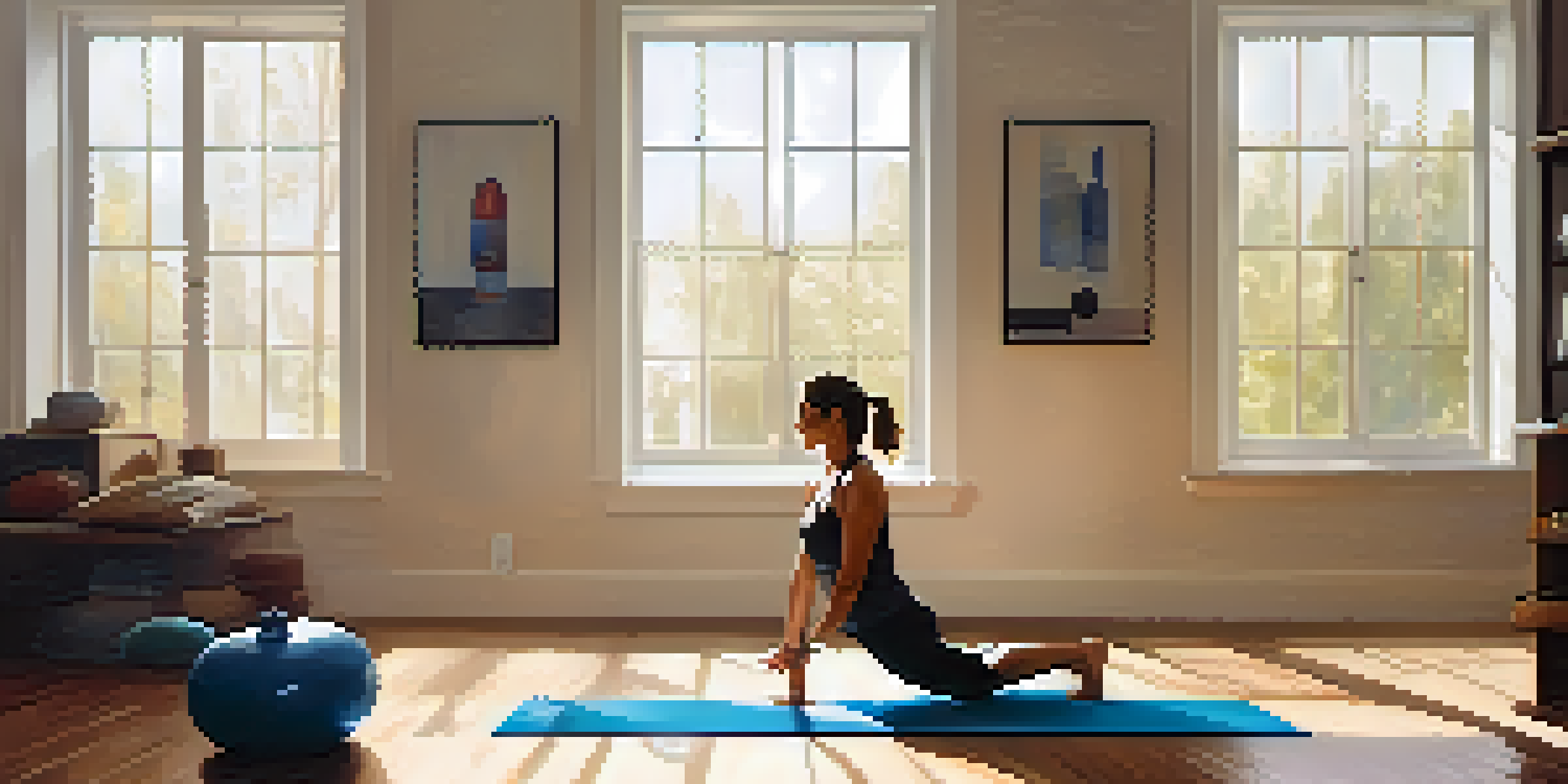Building Muscle with Limited Equipment: Key Exercises to Try

Understanding Muscle Building Basics with Limited Gear
Building muscle doesn’t always require a gym full of equipment. In fact, you can achieve significant results with just a few basic tools or even your body weight. The key is to focus on resistance training, which encourages muscle growth through tension and load.
Strength does not come from physical capacity. It comes from an indomitable will.
When you're working out with limited equipment, it’s essential to prioritize compound movements. These exercises engage multiple muscle groups at once, providing a more efficient workout. Think of them like a multi-tool; you get more done with fewer resources.
Ultimately, commitment and consistency are crucial. Set a routine that fits your lifestyle, and stick to it. With dedication, you’ll see improvements over time, regardless of your equipment situation.
Push-Ups: A Classic for Upper Body Strength
Push-ups are a timeless exercise that can be done anywhere, making them perfect for muscle building with limited equipment. They primarily target your chest, shoulders, and triceps, while also engaging your core for stability. It’s like a mini workout for your entire upper body.

For added challenge, you can experiment with variations like incline push-ups, decline push-ups, or even explosive push-ups. These modifications keep the exercise fresh and help you build strength at different angles. Think of it as upgrading your workout to the next level.
Muscle Building with Minimal Gear
You can effectively build muscle using limited equipment by focusing on resistance training and compound movements.
Incorporating push-ups into your routine a few times a week can lead to impressive gains in upper body strength. Plus, they require no gear other than your own body, making them accessible for everyone.
Bodyweight Squats: Foundation for Lower Body Power
Bodyweight squats are another effective exercise that targets your legs and glutes without any equipment. They help build strength in your quads, hamstrings, and calves, giving you a solid foundation for overall fitness. You might think of them as the bread and butter of lower body workouts.
The only bad workout is the one that didn't happen.
To enhance the difficulty, consider adding jumps or using a chair for elevated squats. This can help keep your muscles guessing and improve your performance over time. It’s like adding spice to your favorite dish—you want a little variety to keep things interesting.
By regularly including squats in your routine, you'll notice stronger legs and better overall stability. Plus, they can easily be done at home or outdoors, making them incredibly convenient.
Dumbbell Rows: Building a Strong Back Anywhere
If you have access to dumbbells, dumbbell rows are a fantastic way to target your back muscles. They help improve posture and balance while working your lats and rhomboids. Think of rows as the secret sauce that rounds out your upper body workout.
You can do rows with one or two dumbbells, and even modify your stance for different muscle activation. If you don’t have dumbbells, a filled water bottle or backpack can serve as a substitute. It’s all about finding creative solutions with what you have.
Importance of Consistency
Commitment to a regular workout routine is essential for achieving muscle growth and strength improvements.
Incorporating dumbbell rows into your routine not only sculpts your back but also enhances your overall strength. Just remember to focus on form to avoid injury and get the most out of each repetition.
Planks: Core Strength for Better Performance
Planks are an essential exercise for building core strength, which is crucial for virtually every physical activity. They engage not only your abs but also your shoulders, back, and glutes, making them a full-body stabilizing exercise. Think of planks as the glue that holds your body together during workouts.
You can modify planks to suit your fitness level, from knee planks for beginners to side planks for added difficulty. The variations keep your routine dynamic and challenging. It’s like having multiple flavors of your favorite ice cream—always something new to try.
Incorporating planks a few times a week will help develop a solid core, ultimately improving your performance in other exercises. Plus, they require no special equipment, making them easy to integrate into your home workout routine.
Lunges: Versatile Moves for Leg and Glute Development
Lunges are a versatile exercise that targets your legs and glutes while helping improve balance and coordination. They can be performed in various directions—forward, backward, or sideways—allowing you to engage different muscle groups. Think of lunges as your personal training partner, always ready to challenge you.
To elevate the intensity, you can add weights or perform jumping lunges. This will not only build muscle but also boost your heart rate, providing a cardio component. It’s like hitting two birds with one stone—strengthening while improving endurance.
Variety Keeps Workouts Engaging
Incorporating different exercises and modifications, like push-ups and lunges, helps maintain interest and challenge your muscles.
Including lunges in your workout routine can lead to stronger legs and a firmer backside. Plus, their adaptability means you can always find new ways to keep your workouts exciting.
Burpees: Full-Body Exercise for Maximum Impact
Burpees are a high-intensity exercise that combines strength and cardio, making them a fantastic addition to any limited equipment workout. They work your entire body—arms, chest, legs, and core—while also elevating your heart rate. Think of burpees as a mini boot camp workout in one move.
Even though they can be challenging, you can modify burpees by removing the jump or stepping back instead of jumping. This makes them accessible for all fitness levels, allowing you to progress at your own pace. It’s like building a staircase—one step at a time until you reach the top.

Integrating burpees into your routine can lead to improved stamina and muscle endurance. Just remember to focus on your form to maximize benefits and minimize the risk of injury.
Creating a Balanced Routine with Limited Equipment
When building muscle with limited equipment, it’s crucial to design a balanced routine that incorporates various exercises. Aim to include movements that target different muscle groups, ensuring a comprehensive approach to strength training. Think of your routine like a well-balanced meal—each part plays a role in your overall health.
A well-rounded routine might include push-ups, squats, lunges, and planks, allowing you to hit all major muscles. You can arrange these exercises in a circuit format for an efficient and effective workout. It’s like creating a playlist; you want a mix of songs to keep the energy flowing.
As you progress, don’t hesitate to adjust your routine to keep challenging yourself. This adaptability is key to continued growth and success in your muscle-building journey.